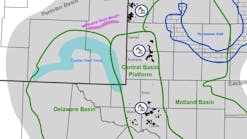E&Y: US oil, gas companies’ reserves, profits up in 2013
A slight decrease in capital spending by US oil and gas companies in 2013 gave way to a 9% increase in oil and gas reserves, strong oil prices, and improving natural gas prices, Ernst & Young reported on June 24 in its annual US oil and gas reserves study.
The study examines US upstream spending and performance data over the past 5 years for the largest 50 companies based on yearend 2013 oil and gas reserve estimates.
Capital expenditures in 2013 declined 7% to $173.5 billion from the previous year. E&Y credits lower unproved property acquisition costs and lower exploration costs for the reduction. Although exploration costs declined 15% in 2013, the level of spending represented the second highest amount of the 5-year study period.
Development spending increased every year of the 5-year study period to reach $106.7 billion. Independents, large independents, and integrated companies each experienced an increase in development spending, but each spent less on exploration.
"While we saw lower capital expenditure numbers in 2013, that is due in part to the advancement in technologies and processes that are making exploration and production less expensive and more efficient," said Deborah Byers, E&Y oil and gas leader.
A 53% increase in after-tax profits to $33.4 billion for the study companies in 2013 was facilitated by an 11% increase in revenues and significant decrease in property impairments, E&Y says. In 2012, study companies reported a 58% decrease in after-tax profits, which E&Y attributed to low natural gas prices (OGJ Online, June 4, 2013).
Revenues reached $199 billion in 2013 as oil production and oil prices increased. Production costs for the year increased mainly because of higher lease operating expenses, and many companies made strong investments in their 2013 operations with a plowback percentage of 125%, E&Y says.
Oil, gas reserves rise
Yearend oil reserves increased in each year of the study and reached 25.4 billion bbl in 2013. After decreasing in 2012 because of downward reserve revisions caused by depressed natural gas prices, yearend gas reserves climbed to 178.7 trillion cu ft.
While natural gas prices fared slightly better last year, positively impacting gas reserves, gas production dipped slightly for the first time in the study's 5-year period.
Extensions and discoveries for both oil and gas reserves in 2013 were the highest of the 5-year study period. These additions for oil reserves encompassed 4.1 billion bbl in 2013 and contributed to an oil production replacement rate of 222%, excluding purchases and sales.
Extensions and discoveries of 29.9 tcf were reported for gas reserves, and the gas production replacement rate was 229%, excluding purchases and sales.
"Large independents accounted for the largest absolute increases in oil and gas reserves in 2013, though the gas reserves still remain below the level we saw in 2011," Byers said.
The US oil and gas reserves study is a compilation and analysis of certain oil and gas reserve disclosure information reported to the Securities and Exchange Commission.
